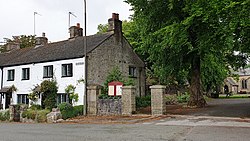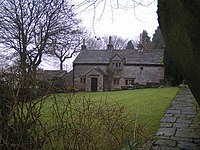Fairfield, Derbyshire
| Fairfield | |
| Derbyshire | |
|---|---|
 St Peters Road | |
| Location | |
| Grid reference: | SK066740 |
| Location: | 53°15’48"N, 1°54’10"W |
| Data | |
| Post town: | Buxton |
| Postcode: | SK17 |
| Local Government | |
| Council: | High Peak |
Fairfield is a village in Derbyshire which has become absorbed into Buxton. It is on the A6 road half a mile to the north east of the town centre. The historic village of Fairfield was centred around a village green.
The name of the village is exactly as it seems, from the Old English fægre feld meaning 'fair field', because of its pastureland.
Churches
The first chapel was built in Fairfield between 1240 and 1255. Fairfield's own church was built in c.1595. It was demolished in 1838 to be replaced by the present parish church, St Peter's. The church stands just north of the Green, built in 1839 to the design of William Swan, the village schoolmaster. St Peter's is a Grade II listed building.[1]
John Wesley visited Fairfleld in September 1784. Fairfield Wesleyan chapel on Waterswallows Road was built in 1868, replacing the first Methodist chapel which was erected in 1844. After 1887 it was used as the Fairfield Local Board Town Hall.
History
Cistercian monks and Benedictine nuns founded monastic granges at Fairfield in the early 1200s (the latter giving a name to today's Nunsfield Farm).
In the 13th century Fairfield (being north of the River Wye) was within the Royal Forest of Peak, a hunting ground for the king.
Fairfield was a chapelry in the parish of Hope (while Buxton was in the Bakewell parish). Fairfield and Buxton shared a mediæval corn mill on the Wye in Mill Dale, where Ashwood Park is now.
Fairfield became a town in its own right, complete with town council.
Fairfield Common was established centuries ago as common grazing land. Buxton Racecourse was laid out on the common in the early 1800s. From 1821 horse racing and cock fighting meetings were held each year in June. The Duke of Devonshire commissioned a grandstand building which stood in the 1830s. In 1835 The Commercial Directory for Derbyshire wrote that an "excellent round course has been formed where horse races take place". Buxton racecourse closed in 1840 and the grandstand was pulled down.
Buxton and High Peak Golf Club was founded in 1887, after a nine-hole course was laid out on Fairfield Common in 1886.[2] The course was extended to 18 holes in 1893. The 9th par 5 hole is called 'Standside', which refers to where the grandstand once stood. The Roman road between Aquae Arnemetiae (Roman Buxton) and Melandra fort (near Glossop) runs along the western wall of Fairfield Common.
The Bull's Head pub on Fairfield Road replaced the previous one which was demolished in 1903.
Fairfield is at the head of the narrow dry gorge of Cunningdale, which is part of the Wye Valley Site of Special Scientific Interest.[3]
References
- ↑ National Heritage List 1257973: Church of St Peter (Grade II listing)
- ↑ The Buxton and High Peak Golf Club
- ↑ SSSI listing and designation for Wye Valley

